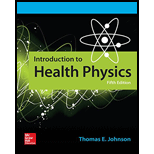
Concept explainers
(a)
Probability of observing exactly 400 counts in 1 minute.
(a)
Answer to Problem 9.1P
Probability observing exactly 400, P(n=400) = 0.02
Explanation of Solution
Given:
Mean activity,
Number of counts per minute, n = 400 cpm
Formula used:
Standard deviation
Where, n = number of counts
Probability
Where,
P(n) = probability of finding exactly n
Calculation:
Standard deviation
Probability
Conclusion:
Probability observing exactly 400, P(400) = 0.02
(b)
Probability of measuring 390 − 410 counts in 1 minute?
(b)
Answer to Problem 9.1P
Probability of measuring range (390 − 410) counts is 0.383
Explanation of Solution
Given:
Mean activity,
Count,
Formula used:
Where,
t = test
Calculation:
Test value for 390 counts
Test value for 410counts
The probability of measuring 390 − 410 counts
Conclusion:
The probability of measuring range (390 − 410)counts is 0.383.
Want to see more full solutions like this?
Chapter 9 Solutions
Introduction To Health Physics
- . A Geiger counter measures background radiation and records 950 counts in 10 minutes. Then the Geiger counter is brought near a radioactive source and it records 1430 counts in 10 minutes. Compute R,, the rate (in counts/min) due to the source only. Also compute &R,, the uncertainty in the rate due to the source only . Suppose in this experiment, the penetration depth in lead is 9.4 mm (whicharrow_forwardQuestion 1. There are four factors: A, B, C, D. We assume that each replicate was considered as a block. Fill in the table as below and analyze the experiment with conclusions. Using a = 0.05. Treatment combination Rep 1 Rep 2 7.786 | 7.377014 6.789 | 6.398278 5.834 5.554411 A C D -1 a - b 2.341 2.28354 6.133 5.702366 3.669 | 3.608621 d ab ас 6.154 5.87312 ad 5.819| 5.550515 bc 12.887 12.62869 2.753 2.261361 4.451 4.411148 0.873 | 0.793026 4.678 | 4.259536 3.728 3.695787 bd cd abc abd bcd аcd 10.478 10.33168 abcd 1.722 | 1.365419 Table 1arrow_forwardA radiographic technique calls for 46 kVp and 28 mAs which results in an exposure of 278 µGy. What is the expected exposure if the technique is changed to 75 kVp and 14 mAs? Round your answer to the nearest whole number. Do not include units.arrow_forward
- A laboratory blood test is 99% effective in detecting a certain disease, when it is in fact present. However, the test also yields a false positive result for 0.5% of the healthy person tested (that is, if a healthy person is tested, then, with probability 0.005, the test will imply he has the disease). If 0.1 percent of the population actually has the disease, what is the probability that a person has the disease given that his test result is positive?arrow_forward(a) A student wishes to measure the half-life of a radioactive substance using a small sample. Consecutive clicks of her radiation counter are randomly spaced in time. The counter registers 372 counts during one 5.00-min interval and 337 counts during the next 5.00 min. The average background rate is 15 counts per minute. Find the most probable value for the half-life. (b) Express the estimated half-life with an appropriate estimated uncertainty.arrow_forwardA Co-60 source gives a gamma dose rate of 120 μSv/h at 2.2 m away. At what distance (in meter) will the dose rate be 59 µSv/h? Provide your answer with 1 decimal place.arrow_forward
- An alpha source was counted for 10 hours at a distance of 2 cm from a detector with an active face area of 500 mm2, If the resulting peak is integrated and found to have 2800 counts under the peak, what is the absolute activity of the source in Bq?arrow_forwardWhat is the total random error in 11 measurements, if you know the single random error is + 11.0 mm? Answer: Choose... +arrow_forwardif a record sample has rate of 44100Hz, how many samples are required to capture 0.25s?arrow_forward
- A beam of 5.0 MeV alpha particles (q-2e) has a cross-sectional area of 1.50 cm2. It is incident on flesh (p-950 kg/m³) and penetrates to a depth of 0.70 mm. a) What dose in Gy does the beam provide to the flesh in a time of 3.0 s? b) What effective dose does it provide? Assume the beam to carry a current of 2.50 x 109 A and to have QF - 14.arrow_forwardA mouse has a thickness of approximately 20mm. Assume the mouse is completely composed of the ICRU4 tissue material that has a density of 1g/cm3. At 20keV, the mouse received a skin entry or surface dose of 5mGy. What would be the number of photons per cm2 incident on the mouse? the total dose that the tissue receives through the entire 20mm thickness. the skin or surface dose at the exit of the animal? Note the ICRU4 :arrow_forwardThe linear attenuation coefficient for 2.0-MeV gamma rays in water is 4.9 m-1 and 52 m-1 in lead. What thickness of water would give the same shielding for gamma rays as 15 mm of lead?arrow_forward
 University Physics Volume 3PhysicsISBN:9781938168185Author:William Moebs, Jeff SannyPublisher:OpenStax
University Physics Volume 3PhysicsISBN:9781938168185Author:William Moebs, Jeff SannyPublisher:OpenStax
